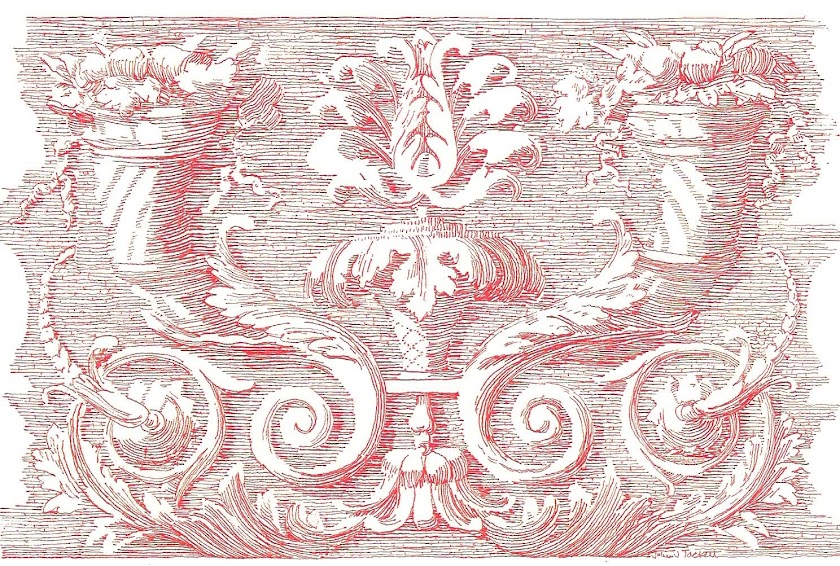 |
| The office of The Very Reverend James Parks Morton. |
An office, especially an executive's, should say something about the individual. All these examples come from that Golden Age when
The New York Times Magazine was eagerly awaited, the first section to be viewed after picking up the Sunday edition at the newstand late Saturday evening. In the late 1970s and early 1980s, this separate section of the newspaper, the only part with color photography, was at the forefront of styles and trends, truly a finger on the pulse of what America was thinking -- or about to think. Editor Carrie Donovan, 1928-2001, had a knack for recognizing what would become popular. Formerly fashion editor for
Vogue and
Harper's Bazaar, she was an early supporter of Donna Karan, Perry Ellis, and Paloma Picasso. In her later years, she became a widely-recognized celebrity as a spokesperson for Old Navy, appearing in 42 television ads.
 |
Carrie Donovan.
Photo from Google Images. |
The Cathedral House on the grounds of the (Episcopal) Cathedral of St. John the Divine was orginally built as the bishop's residence in 1911. Designed by architect Ralph Adams Cram, the funds for construction were donated by J.P. Morgan. In the 1950s, architect Frederic Rhinelander King, cousin of author and taste-maker Edith Wharton and partner in the New York office of noted Palm Beach architect Marion Sims Wyeth, converted the first floor into offices with the bishop's apartment on the second floor. The office of the dean (the head of the Episcopal churches in New York City), the Very Reverend James Parks Morton, is pictured here in the first image. Originally the library of the house, this office is blessed with remarkable architectural features: leaded glass windows with stone surrounds of gothic tracery, oak beams with carved stone corbels, tall bookcases, and a medieval style fireplace (not shown). The office served as center of many diverse projects, from the completion of the cathedral and the attendant training programs (in stone cutting/carving, woodcraft, iron-working, etc.) to solar design to visual and performing arts programs. Dean Morton's personal touches included his collection of rocks found in East Hampton, Long Island, and Colorado, and peacock feathers, shed from the four birds that roamed the grounds of the cathedral. Further decoration was provided by cathedral drawings, charts and personal photographs. And the contribution of the semi-antique Heriz rug is not to be under-rated. This image shows the turn-of-the-century English Arts & Crafts desk set for an informal lunch with food from a local delicatessen.
 |
| The office of Mary Wells Lawrence. |
Advertising legend Mary Wells Lawrence, board chairman of Wells, Rich, Greene knew how to close a business deal. In addition to creative talent, she gave the client personalized service, whether it was entertaining at her summer home La Fiorentina, featured in previous posts of The Devoted Classicist
here, here, and here, or her own office. Her interior designer, Arthur E. Smith, protege of Billy Baldwin and later his business partner until Baldwin's 1971 retirement, furnished the office as a fresh-but-sophisticated Living Room. Comfortable upholstery slipcovered in bright fabric of white fern fronds on yellow, matching Roman shades, a yellow and white geometric rug, rattan armchairs (a favorite of Baldwin), a Smith-designed work table for the desk, and a William & Mary lacquered chest give the space the intimacy and down-played luxury of an Upper East Side apartment. Mrs. Lawrence began her workday at home at 6:30 am, according to the article, was in the office by 9:00 am and stayed until 9:00 pm, seldom leaving for lunch; instead, she preferred to invite clients in. The 1974 design has held remarkably well.
 |
| The office of Diane Von Furstenberg. |
In interesting contrast, fashion and cosmetics executive Diane Von Furstenberg told the Switzer Group, designers for her corporate offices, that she wanted the interiors to look like a cross between an ocean liner and the set of an Esther Williams film. The most striking feature is the plush bright pink carpeting covering the floor and the curving steps to the terrace. The Art Nouveau desk was a gift from her father, and the pair of gray velvet Art Deco chairs were a gift from her close friend and associate Olivier Gelbsmann, the interior designer.
 |
| The office of Halston. |
Fashion designer Halston had a 100 by 26 space on the 22nd floor of Olympic Tower fronting Fifth Avenue to service as an office, workable studio, and showroom. Designed in collaboration with architects Gruzen & Partners, the space had large mirrored doors that would divide it into as many as four separate rooms or open as one, creating an elegant setting for fashion shows as well as luncheons, dinner dances, and charity benefits. Furnishings, stored in a warehouse when not used, included banquettes, tables, more than three hundred chairs and two dance floors. Halston chose the red carpet to anchor the space. "Living high up in New York, everything is gray," he said, "I needed something that would stabilize the space so the room wouldn't float."
 |
| The office of Beverly Sills. |
Although it also had red carpet, the office of director of operations for the New York Opera Beverly Sills had no windows. "I work best surrounded by things I need and love," said Miss Sills. Memorablia and furnishings from her family homes decorated the space.
All the photos, except as noted, come from LIVING WELL, THE NEW YORK TIMES BOOK OF HOME DESIGN AND DECORATION, edited by Carrie Donovan, published by Times Books, 1981. As the virtues of the book have often been lauded by design blogs such as
The Peak of Chic, copies are seldom found for sale. However, scarce vintage copies may be found
here.






